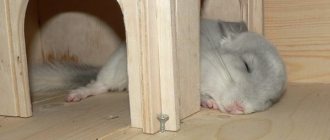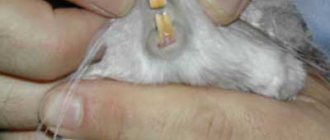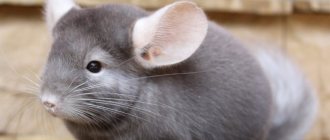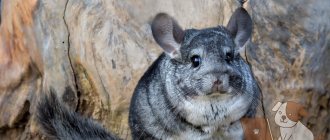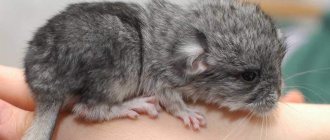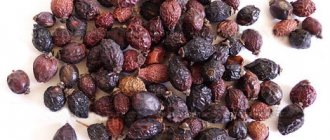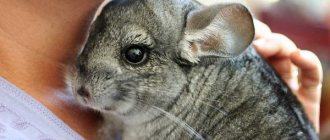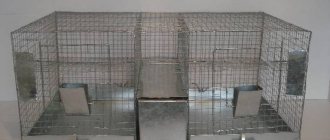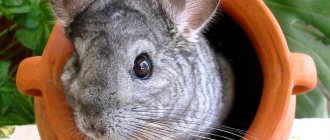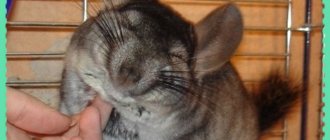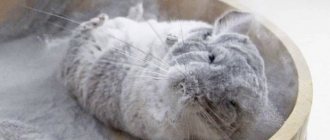We can say that chinchillas are ideal pets. These beautiful, intelligent and sociable animals with fluffy fur do not smell and do not cause allergies.
Chinchillas almost never bite. Most rodents willingly go into the arms of the owner and examine clothes, hair, and jewelry. Animals can sit on a shoulder or head for a long time, and even move around the room in this way with their owner. True, it is rare, but there are individuals who cannot tolerate any attempts to touch themselves. The extreme degree of hostility of the animal is an attempt to “shoot” at the “offender” with a stream of urine. Typically, animals that grow up on a large farm and do not have close contact with people are prone to this behavior. But it is quite possible to rehabilitate such a disgrace. Just let your pet feel attention and affection. If all your communication boils down to cuddling the chinchilla like a kitten, this will lead to the opposite results. This attitude is perceived by most animals as aggression.
One chinchilla - female or male
You have decided that you only want one chinchilla as a pet.
You can choose either a female or a male. In both cases, chinchillas will be able to live quietly alone. You, as the owner, pay attention to your pet, play with your chinchilla regularly and the animal will not feel lonely.
From the experience of our nursery, it was noticed that males and females are equally good at taming. The peculiarity of males is that they are more playful compared to females. Male chinchillas are more active, playful, and love activity and games with humans. Unlike males, female chinchillas are calmer, although there are exceptions. Males and females that have been tamed since childhood willingly go into arms and allow themselves to be caressed without breaking away from their hands. Of course, a chinchilla is not a cat that can stay next to its owner for a long time; the more valuable are those moments when you can fully experience the unsurpassed tenderness and warmth of your chinchilla.
Let's summarize: the pros and cons of keeping a chinchilla in the house
pros
- does not require regular walks around the apartment;
- clean, does not emit unpleasant odors;
- sleeps a lot, does not require special attention;
- easy to care for, chinchilla does not stink;
- a smart animal, interesting to talk to;
- It is interesting to watch her from the side during activity.
Minuses
- almost impossible to tame;
- makes noise at night;
- may chew on property;
- weak immunity.
Kid or adult
Baby chinchillas become independent at the age of 2 months, and from that moment on they can find new owners. At the age of 7 - 12 months, chinchillas are fully formed as adults. Watching a baby chinchilla and playing with him is very interesting and exciting. A baby chinchilla needs careful care, affection and care, because at an early age there is a risk of hereditary or generic diseases.
In the photo: A 2-month old chinchilla is ready to go to a new family.
An adult chinchilla has the advantage that it is already physically strong, has life experience, its character has developed, and the future owner has a good idea of what quality of pet he is buying. In our nursery we prefer to purchase already grown chinchillas aged 10 months and older. It is at this time that it becomes clear how healthy the chinchilla is and what its potential is in terms of weight, exterior and fur quality.
Choosing a chinchilla: getting a healthy pet
To choose a healthy chinchilla, first examine it from all sides. Try to be objective so as not to face treatment or even the imminent loss of your pet in the future.
Inspect your chinchilla before purchasing
Healthy chinchilla:
- active, mobile, does not limp, does not drag its tail, does not fall on one of its paws, does not rub its muzzle with its paws too often;
- eyes are bright, shiny, looking at the world with lively interest; without any discharge. If discharge is visible in one eye, then this is most likely a sign that particles of dirt, dust, or leaks have entered the eye. But discharge from both eyes is often a symptom of an infectious disease;
- nose is dry, clean, no discharge, no sneezing. Yellowish mucous discharge from the nose is a symptom of an infectious disease. Sneezing in chinchillas can be caused by high humidity, from being in a dusty room, or is a symptom of a cold;
- The ears are clean, without scabs on the inside or outside of the ear. The inflammatory process and scabs on the outer or inner part of the ear should alert the future owner. You need to carefully examine the ears; the presence of scabs may be a sign of mite damage to the chinchilla’s ears;
- breathing is even, not hoarse, without whistling;
- the body (pick up and determine by touch) is moderately well-fed, not skinny, without protruding ribs;
- the fur fits tightly to the body, is clean, shiny, smooth, bald spots in the fur are unacceptable. Tousled hair in most cases is a symptom of some disease;
- the skin is clean, without inflammation, wounds, dried purulent crusts, scabs and visually noticeable ectoparasites. The condition of a chinchilla's skin can be determined by running your hand against the fur. Dried particles on black skin may indicate the presence of fleas on the animal;
- The cloaca is clean, without sticky hairs from feces. Hair stuck together in the anus is a sign of diarrhea in the animal, which means that the chinchilla is not properly maintained, is fed poor quality food, or is suffering from a contagious disease.
The health of a chinchilla is reflected not only in appearance, but also in behavior. If an animal sits in a cage, huddled in a corner, listless in appearance, with its eyes closed, and even with disheveled fur, then it is probably unhealthy.
Ready-made pair or to choose from
In the wild, chinchillas live in herds of 10 to 100 individuals. The chinchilla is a collective animal, so keeping a pair of chinchillas is more consistent with the nature of the animals than keeping them alone.
Ready-made pairs of chinchillas are rarely offered for sale. Previous owners sell them because the animals are old or if the couple is childless. And if you do not plan to engage in breeding, then this option is acceptable. Sometimes couples who have previously had children and chinchillas are of childbearing age go on sale. Such a couple can still bring you offspring. Find out from the seller how many litters the couple had previously and what quality the chinchillas turned out to be.
The most interesting thing, from a breeding point of view, is to select pairs of chinchillas. The selection process is the main thing in the work of a breeder. The purpose of selection is to obtain offspring with new variations in color and fur quality. To succeed, you need to know the pedigree of chinchillas and the laws of genetics. Do not attempt to breed chinchillas unless you have the necessary knowledge; some gene combinations can be lethal. If you buy chinchillas from a breeder, you will receive advice about the likely quality of the offspring.
If you have one chinchilla and you decide to buy a second one, know that you cannot immediately put two chinchillas in one cage. Whether they are same-sex or opposite-sex animals, their reaction to each other can be sharply aggressive. Raising chinchillas is a separate and large topic, which is described in the section on breeding chinchillas>>> .
In the photo: A pair of chinchillas for keeping as pets
Preparing to purchase a chinchilla
If you decide to have an exotic rodent at home, you should prepare your apartment for this event in advance. Before a chinchilla appears in the house you need to:
- Buy a chinchilla cage or make one yourself.
- Purchase the necessary equipment - a drinking bowl, a feeding trough, a hay barn, a house, a swimming pool, toys, a pallet.
- Purchase cleaning and disinfection products, mineral stone, filler, volcanic sand for bathing.
- Stock up on hay, food, and tree branches.
- Prepare a place for the animal to walk.
- Conduct an explanatory conversation with children.
- Look for a veterinary clinic closer to your home and make an agreement with the veterinarian in advance.
Same-sex couples are better pets than singles
If you do not want to have offspring from chinchillas, care for a pregnant female and newborn chinchillas, you can consider the option of creating a same-sex pair. Female sisters or male brothers are ideal for this. They, being relatives, have been together since childhood. A pair can be formed from unrelated females or males if they are mated in childhood. Kids quickly get used to each other and will not conflict when they grow up. In our nursery, chinchillas that have reached the age of 2 months are separated from their mothers into common same-sex groups.
To keep as a pet, we recommend purchasing a pair of same-sex chinchillas. A single pet will experience stress from loneliness, but two chinchillas will play with each other and never get bored.
Where to buy chinchillas?
Today you can buy a chinchilla in many pet stores, on the market, and also in nurseries. The best option is a professional nursery, because there is a high risk of buying a sick animal on the market. Pet stores also do not provide any guarantees on animals and, once you have paid for your purchase, disclaim all responsibility for live goods.
Therefore, the best option is to contact a nursery that has a positive reputation among lovers of these furry animals. Nursery owners have extensive experience in keeping and breeding chinchillas, and many have veterinary or biological education. From them you can get professional advice on how to care for and what to feed the animal. In addition, in its usual environment, the chinchilla behaves naturally and does not huddle in corners. And in a pet store, the animal usually hides in a corner, fearing noise, the abundance of strangers and bright light.
Mini-farm registration
At the initial stage, there is no need to officially register a chinchilla business, since it will take about six months to raise the first litter, from which several individuals can be sold.
Before implementation, you need to choose one of the registration options:
- Individual entrepreneur. Suitable for a single business owner.
- Farming. Relatives can participate in the enterprise, but for this it is necessary to draw up an agreement.
To pay taxes, it is most profitable to choose a single agricultural tax at a rate of 6% of profit.
No license or other permits are required to raise chinchillas. It is necessary to register with the veterinary service.
How to get used to a name?
In the first days of the animal’s life in the family, you should think about a nickname for it - watch the new resident, his habits and activity, then it will be easier to make a choice. It is believed that chinchillas have the highest level of intelligence among all rodents, so over time, the furry friend will learn his name and respond to it.
Coloring, size, character - all this can be a source of inspiration when choosing a nickname
When choosing a name, you should follow a simple rule: the nickname should not be too complex or long. It is enough for the name to consist of 3-6 letters. It is best to choose a nickname that contains soft hissing sounds - the animal will get used to this name faster. In order for your pet to remember it as quickly as possible, you need to follow a simple algorithm:
- Call your pet by name in a gentle voice when you pass his cage.
- Feed the animal according to the schedule, at the same time in the evening. Pouring food. Repeat the chinchilla's name several times.
- Periodically treat your pet with a treat (chinchillas especially love raisins), calling him by name. But you should not overfeed the animal, otherwise it may develop diarrhea.
The animal only needs 1-2 raisins per day. More sweetness will lead to indigestion.
How does childbirth proceed in chinchillas?
Before giving birth (2-3 days before), the females remove the bathing suit with sand from the cage, and the nesting house is turned over with the hole facing up. In this position of the house, the female will not be able to throw out of it the material laid there for insulation (hay or straw is usually placed as bedding). 3-6 days after birth, the nest box is turned with the entrance to the side so that the puppies can freely crawl out of it. In cool weather In weather conditions, it is advisable to heat the nest using an electric heater. Such measures will contribute to the normal course of labor and help maintain the health of the female. Before giving birth, the female chinchilla makes a nest for herself in the nesting house. She begins to crush the bedding with her teeth, puts it in a heap, and begins to pluck out her fluff in the belly and chest area. All down plucked by the female should be left in the nest. It happens that a chinchilla does not build a nest for itself, then the owner needs to make it himself from hay and line it with down. As the birth approaches, the female moves little and often lies on her side. During the prenatal period, the animal reacts with increased anxiety to extraneous noises, sudden movements of an approaching person, and flashes of light. It is better not to disturb a pregnant chinchilla again, as its stressful state can be very dangerous in the future. A disturbed female is quite capable of killing or eating her cubs. In order to protect the female from unnecessary worries, the nest is covered with a dark cloth.
During this period it is necessary to handle it with extreme care and caution. When a chinchilla is pregnant and the time is approaching childbirth, the animal should not be picked up
If it is necessary to better show the animal to a veterinarian, pick it up carefully, supporting the belly with your hand from below. In a cage where a pregnant female lives, the bedding needs to be changed more often. It is ideal if the bedding is good wood filler or dry and fresh finely stemmed hay with low thermal conductivity. This bedding retains heat for a long time, so it is of particular value in the cold season. There should be fresh water in the chinchilla cage at all times. The female gives birth between 5-8 am. After giving birth, she can be given sugar, not in large quantities up to 2 grams. The female feeds the puppies with milk, which appears within 24 hours after birth. When examining, seeing that the puppies are “sitting” hunched over and squeaking loudly, you need to carefully and carefully examine the female herself and make sure that she has no milk - the puppies must be fed “artificially”. For this purpose, milk powder is diluted 1:2, condensed or concentrated milk is diluted in the same proportion. Cow's milk and goat's milk are suitable. For the first three days, puppies are fed eight times a day.
The female may become covered again with a male the very next day after giving birth.
Puppies are separated from the female even at one month of age, provided that they are fed boiled milk. But the chinchilla cage must be well insulated. As a rule, the released young animals are kept in spacious cages, several heads each, females and males are separated. And they can live together for up to five months.
With annual counting and analysis, there are usually 5-10% more boys born than girls.
For further breeding, active, strong, good physique and high-quality hair are left. Preferably from fertile parents.
In general, there are no problems with these animals. The female chinchilla is a very caring and good mother!
Diseases: how dangerous they are and how to treat them
These animals have strong immunity, which is why, with proper care, they rarely get sick. But being in unfavorable conditions can negatively affect their well-being. If the animal experiences a loss of appetite and decreased activity, this is a cause for concern. The following diseases are typical for chinchillas:
- Bronchopneumonia is accompanied by fever, difficulty breathing, nasal discharge, cough and wheezing. The animal is treated with glucose and vitamins. And also small doses of penicillin. This drug is prescribed intramuscularly once every three days. The dosage must be agreed with your veterinarian.
- Rectal prolapse. This causes constipation. The fallen part is first treated with furatsilin solution, then with paraffin oil and, using a pipette, carefully set.
- Formation of hair rings around the male genitals. This prevents it from reproducing. The rings are removed by hand. If they are dry, they are treated with a soap solution.
- Constipation. It can be caused by a lack of fluid and changes in diet. If there is such a problem, dry food is excluded. The pet is given a laxative and paraffin-based oil is injected into the mouth or rectum.
- Keratitis is a lesion of the cornea of the eyes. The disease occurs due to contact of the chinchilla with poor-quality sand or mechanical damage. The eyes are washed with furatsilin and treated with levomecithin or tetracycline ointment.
- Dental diseases occur when there is no stone to grind down. The animal's incisors reach 8 cm and injure the tongue. The molars move. The chinchilla is unable to eat and dies. Treatment involves grinding down the teeth, but this procedure must be performed by a veterinarian.
- Conjunctivitis manifests itself as purulent or clear discharge from the eyes. May indicate the presence of an infection. The animal's eyes are instilled with fluorescent, then treated with eye ointment every hour.
- Ticks. They can be detected after careful observation of the animal. The chinchilla's skin peels off and becomes thicker, and the animal suffers from itching. The animal loses weight, and in the absence of adequate treatment, dies. The wool needs to be cut, and the affected areas should be treated with bromocyclene at intervals of 8 days. The dosage is prescribed by the veterinarian. You will also need to disinfect the cage.
- Flatulence occurs as a result of feeding poor quality food. The animal's temperature drops to 34.5°C, and its general condition worsens. The animal is given activated carbon in powder form. You can use dill water or chamomile infusion. It is better to coordinate treatment with your veterinarian.
- Otitis is an inflammatory process that affects the external auditory canal. It is the result of pollution. The disease can be detected by the leaking brown liquid. The ear is treated with fish oil and ointment containing zinc.
- Diarrhea – occurs due to stress and unbalanced nutrition. The animal's temperature rises. He is given oak bark, maple leaves and activated carbon.
- Heatstroke. This ailment can be recognized by observing the behavior and appearance of the animal. It lies on its side, the ears turn red, and copious amounts of saliva appear. The chinchilla is moved to a cool place and a cold object is placed in the cage. For example, a bottle filled with cold water.
- Ringworm – baldness appears on the back, sides, head, neck and tail. The skin peels and becomes inflamed. The animal is treated with a 5% iodine solution, medical sulfur or fungistop.
Which chinchilla to choose
Experienced breeders are of the same opinion on the question “how to choose a chinchilla”:
- It is better to buy two-month-old babies, so the pet will sooner become a member of your family.
- A healthy puppy should not weigh less than 200 g.
- Shiny, clean fur indicates the absence of health problems.
- A healthy baby has clear eyes without pus or whiteness.
- There should be no redness or other traces of lichen on the animal's skin.
Chinchillas come in different colors
Negative…
- Chinchilla loves to chew everything in its path. Therefore, free movement around the house will result in chewed furniture and wires.
- The animal's house occupies a fairly large space.
- If you forget to keep your chinchilla's house closed, it can run away, and finding your pet will become problem No. 1.
- Quite a lot of dirt and dust from the contents. For example, the formation of dust in the house every time after swimming in the sand.
- The animal does not tolerate drafts, temperature fluctuations, or high indoor humidity.
- The rodent is active at night, which contributes to sleep disturbance due to the noise made by the animal.
- Since this is an exotic animal, if there are any diseases, it is difficult to find a veterinarian who specializes in such species.
Colors of domestic chinchillas
An ordinary chinchilla has a gray-blue color with white spots located in the belly area. In addition, representatives of the mentioned family naturally have a rich color. It is important to note that there are nine main colors of chinchilla fur. However, as a result of selection, the number can increase to 150 different new shades. Traditional gray color can change from darkish to lightish shade.
So, there are many breeds of domestic chinchillas, but the main ones are:
Gray common chinchilla
Gray-blue color of the body with white patches in the belly area.
Chinchilla “black (dark) velvet”
This breed was bred in the sixties of the last century. The main color of this species is black. Moreover, on the paws of representatives of the described breed there are different lines. It is important to note that the darker the color of the fur, the higher quality it is. Particular attention should be paid to the shape of the ears and muzzle of this species.
Chinchilla "snow-white Wilson" (Wilson's white)
Initially, the breed was creamy-coffee in color, but over time it acquired a variety of shades: from snow-white to silver. However, as a rule, the type presented has dull spots on the head. The back color of these chinchillas is white.
Chinchilla with "beige color"
This breed appeared due to a random mutation. A distinctive feature of the “beige color” are coral-colored ears and red irises.
Chinchilla with homobeige color
This breed is distinguished by the presence of exclusively beige type genes. Representatives of the species stand out due to the brilliant color of the back, which has a light coral tint. No less important differences are the creamy-lilac ears and lavender eyes.
Chinchilla with “brown velvet”
Appeared thanks to the hybridization of black and beige velvet. This species has a pair of dominant genes. This breed got the color of its ears and eyes from a beige chinchilla, and the line of its paws from a black one. It is important to note that the color of the fur can vary from woody to chocolate.
Chinchillas with white and pink velvet
They are characterized by two dominant features. The color of the body can be either smoky or pinkish. Eye color also varies from brick to light coral.
Feeding at home
The animal should be fed once a day from 5 to 9 pm. High-calorie foods can cause obesity in your pet, so you should not get carried away with such feeding.
The rodent's menu should include:
- raisins, dried apricots
- hay
- nuts, rose hips
- bread crusts
- special feed
- fruits, such as apples
In general, these animals are quite capricious when it comes to food. The fact is that you can only feed an animal with high-quality food that is suitable for it, quite expensive, foreign-made food, which is designed specifically taking into account the characteristics of the animal. Unsuitable food can be destructive. After purchasing a chinchilla, find out what you fed it before and, if necessary, gradually switch it to a new diet. The veterinarian will advise you on the best menu. In addition to feed, the animal is given hay and oats. You will also need a special stone to point the teeth. Poor quality is just as dangerous: the animal can damage their teeth.
Chinchilla - what is important to know before buying it?
So, if you decide to get a chinchilla, you need to learn as much as possible about the characteristics of these animals. Firstly, the amazing plush fur of chinchillas should never be wet. But this does not negate the need for careful care: the pet will need to be regularly bathed in a kind of sand bath. Secondly, it should be remembered that chinchillas are nocturnal and are extremely afraid of loud noises. Therefore, if you cannot provide peace and quiet at home, it is better to refuse the purchase.
Another feature of chinchillas is their playfulness and jumping ability. You will need space for a large tall cage. The minimum size is 80 cm in height, 50-70 cm in length, 40-50 cm in width. When equipping the cage, you should take into account the fact that due to their hyperactivity, chinchillas are susceptible to injury. In addition, they may fall in their sleep. Therefore, all shelves and structures in the cage should be made of wood and located at a short distance from each other.
Finally, about nutrition. Chinchillas should be fed with special food from a pet store and under no circumstances should they be spoiled with handouts from the table. It is better to consult with a breeder or specialist about choosing a manufacturer, since everything is quite individual in this matter.
What to feed?
A properly formulated diet for a pet is the key to its health. The basis of chinchilla nutrition is special ready-made dry food, which should be purchased at pet stores. The purchased diet is ideally balanced for feeding a pet and is divided into types, depending on the age of the rodent. It contains all the necessary minerals and trace elements for growth and normal development.
It is necessary to put food in the feeder every evening before bed, when the pet's activity phase begins. The following additional components should be present in the chinchilla's diet as a treat:
- green plants : clover, yarrow, alfalfa, nettle, dandelion, apple and hazel branches;
- fruits and berries : rose hips, figs, raisins, dried apricots, beets, dried carrots, dried apples;
- hay of legumes , cereals, multi-colored and asteraceous crops.
Delicious berries
Some foods are contraindicated for chinchillas, for example, cabbage and raw potatoes. The rodent's stomach will not be able to digest meat products, cheeses and milk. You should not spoil your pet with food from the table, since such a treat will give him severe stomach pain in the future.
The following herbs are poisonous to rodents:
- horsetail;
- fern;
- buttercup;
- henbane;
- St. John's wort.
3.Habitat: (Cage installation is very important)
These crazy little rodents require a lot of exercise and will benefit from a large cage with different levels to jump around and exercise their legs. Wooden sleeping huts are a great idea to help your little chinchilla feel safe and provide them with a clean, dry place to sleep. Keep in mind that chinchillas chew plastic, so it is always best to use huts made of wood or hay. As mentioned earlier, chinchillas are very active animals and require a lot of exercise. That's why an exercise wheel is a must! Ideally, the wheel should be at least 15 inches in diameter, and wheels with ball bearings are preferred. Always place their cage in a well-lit area, but DO NOT place the cage in direct sunlight or in a draft.
Suitable bedding materials include wood shavings, newspaper, shredded paper, recycled wood waste, or cardboard. Chinchillas also need nesting material. Any type of soft shredded paper/bed linen will work for this purpose. You should always provide bedding at the base of the cage to absorb debris, as well as nesting materials in the cage and nests for your chinchillas to rest on. It is best to use aspen shavings and always avoid cedar (as cedar oils are harmful to chinchillas).
Chinchilla cat standard
Chinchillas are solid and stocky cats. Their image is enhanced by their thick, dense coat, which gives their body a pleasant softness and roundness. Chinchilla cats are noticeably smaller than males, so the latter are always more popular among lovers of textured pets.
The chinchilla color is documented for representatives of three breeds:
- Persian;
- British (short-haired and long-haired);
- Scottish (straight and fold).
Individuals belonging to the Persian clan have longer fur and have super fluffy tails, the hair on which can be twice as long as on the body. The body standard of Persian chinchillas is the same as that of their eastern counterparts, but with minor additions. In particular, the noses of representatives of the first variety are not so short, so the problems of difficulty breathing, characteristic of brachycephalic breeds, are inherent to them to a lesser extent.
British chinchillas are large pets with round heads and chubby cheeks. Their eyes are wide apart, their ears are small with rounded tips, their noses are wide and short. Coat type: semi-long or short. In fact, all representatives of this branch differ from the traditional British only in color. All other characteristics are inherited by pets from their relatives in full. Typically, representatives of this type of chinchilla are silver or golden in color, but the latter option is less common.
Scottish “mix” chinchillas fully fit into the standard of Scottish folds and straights: the same slender legs, muscular body and raised pads on the face. The animals' fur is silver or peach with darkened tips. The hair itself is dense, short, but without a pronounced fit to the body. Acceptable iris colors for Scottish chinchillas are green and blue.
5.Chompers:
Dental care is essential for chinchillas because their teeth (like most members of the rodent family) are constantly growing. If you notice that your pet is eating less or suddenly stops eating all together, it is recommended that you make an appointment with your veterinarian for a consultation. Chew toys are a great way to maintain oral health. The best chew options are wooden fruit tree branches, wooden chew blocks, and lava chew toys. Timothy or grass hay also helps wear down ever-growing teeth and is a vital part of your chinchilla's nutrition and care.
Teeth trimming
Although this article was focused on chinchillas, I hope it helps everyone understand the amount of research and questions to ask before introducing a new pet into your life and home. Remember to always do your homework, but also be aware of your veterinary team or check out College Manor Vert Hospital - they are a great resource with a wealth of knowledge and past experience to share. We're just waiting to be asked!
